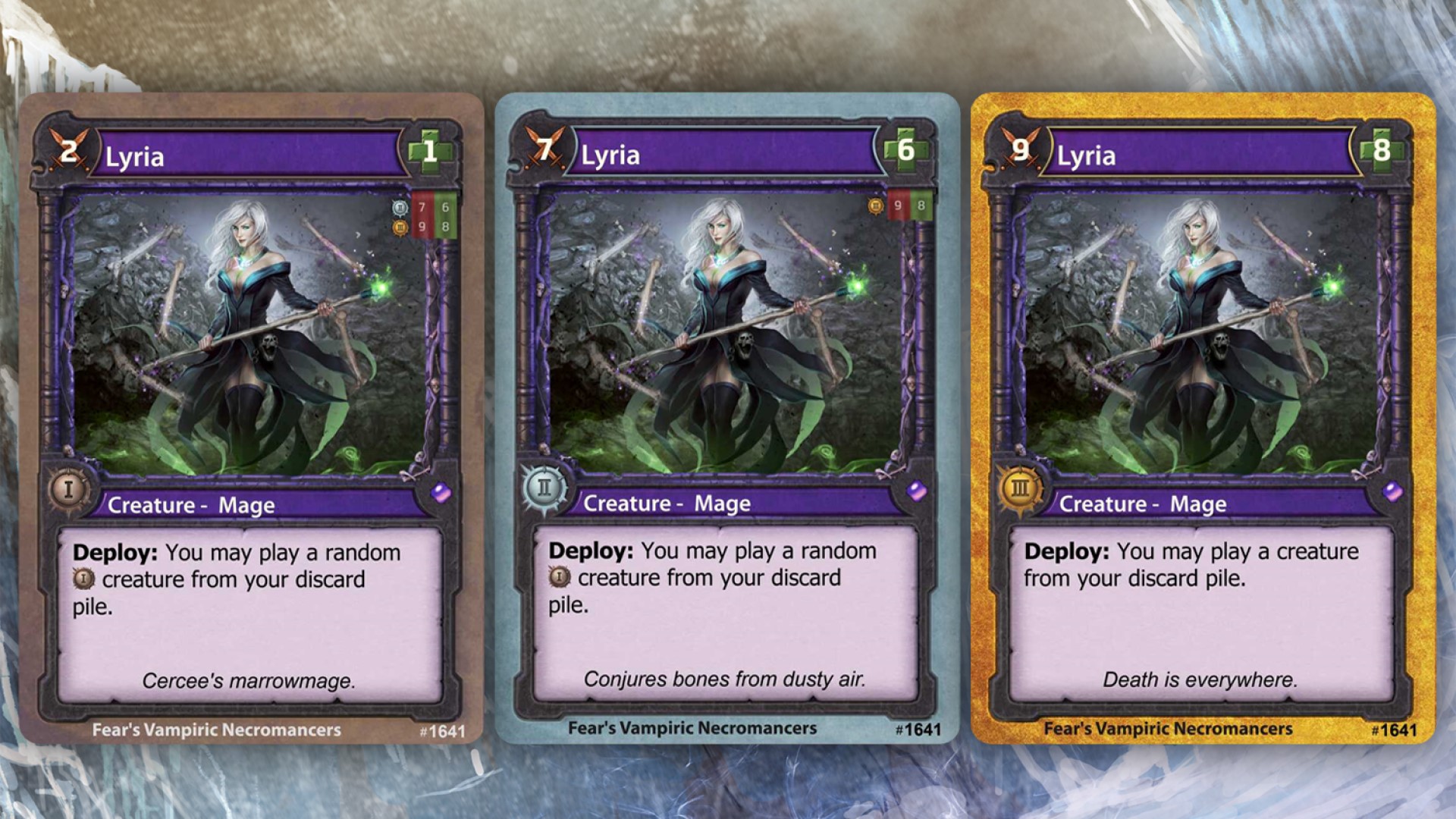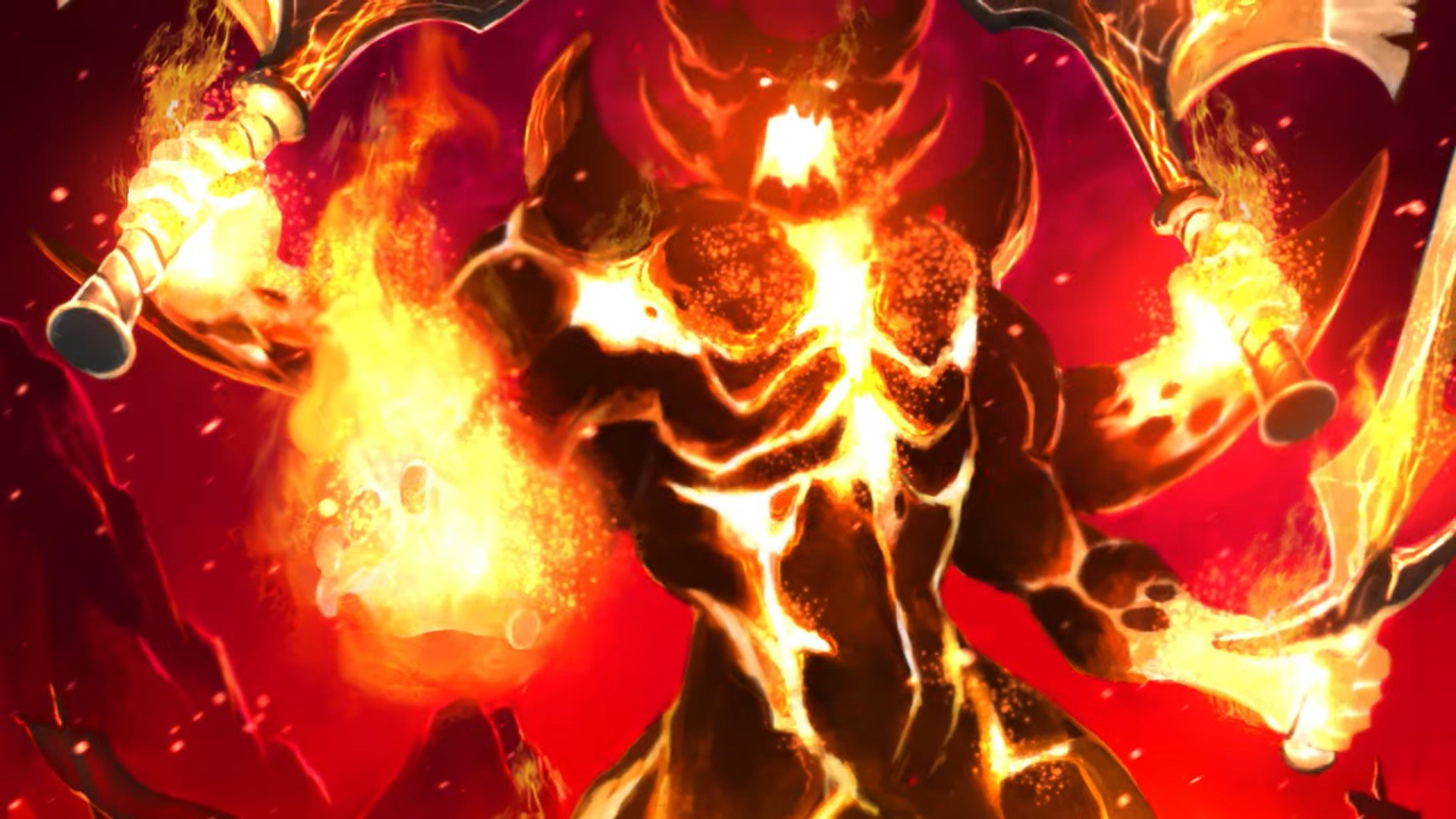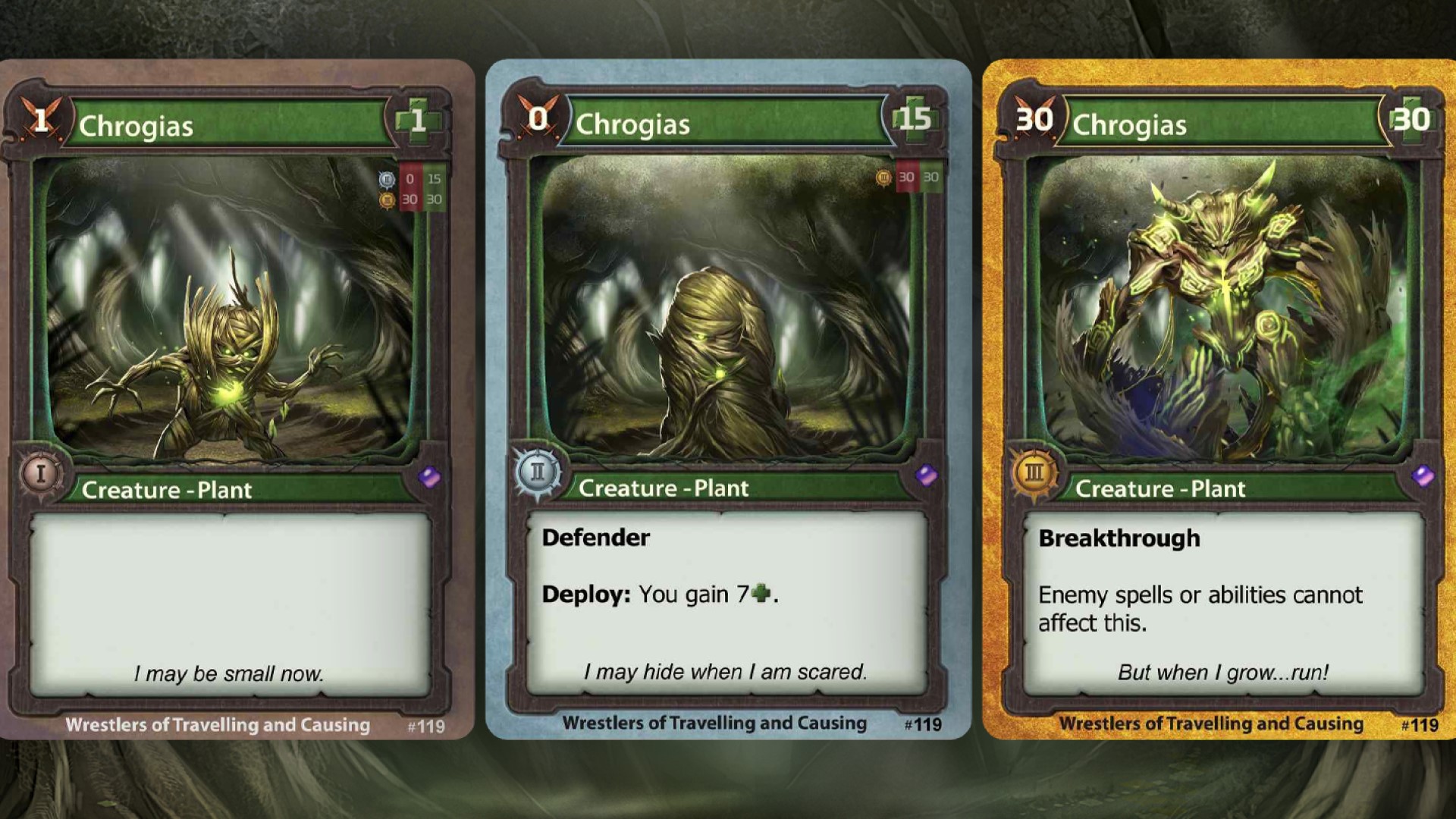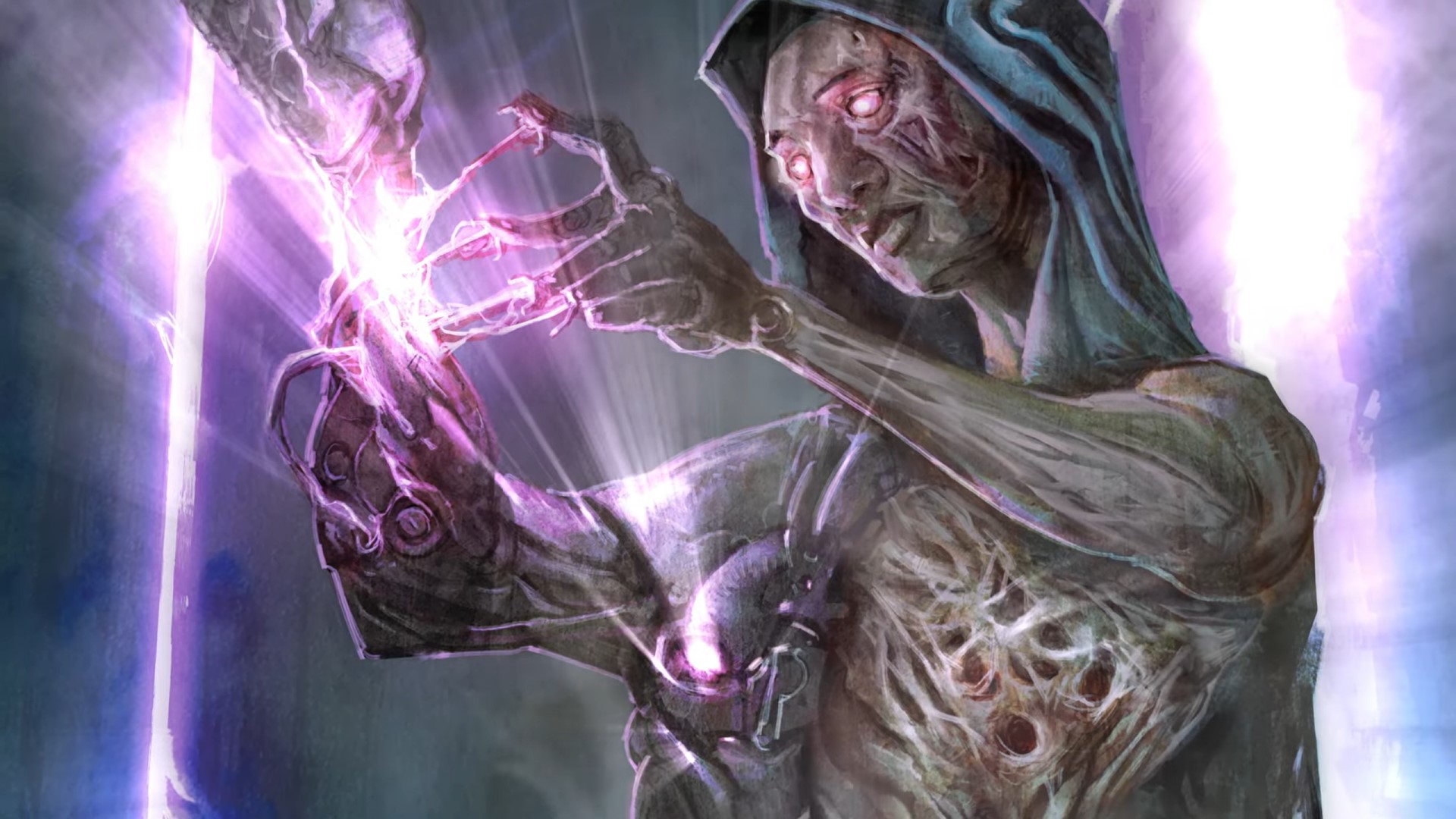Solforge Fusion, a card game created by Magic: The Gathering maker Richard Garfield, and Ascension creator Justin Gary, launched on October 27. Branded as ‘the world’s first hybrid deck game’, it’s a game in which players fuse unique, algorithmically generated half-decks together to form a whole, then do battle in a strategic, lane-based combat system, with cards that level up during play.
This launch is actually the second iteration of Solforge – which originally came out as a free-to-play digital CCG back in 2013, but shut down in 2017, a year out of early access. Now, thanks to a successful Kickstarter, it’s back – as a physical game you can hold in your hands. After a very odd delay, caused by the game’s entire stock getting trapped at a train station, it was released across the US last Thursday.
We spoke to Solforge Fusion’s co-creator Justin Gary about the game, to find out about its development, its community – and, unusually, how its future cards and storyline will be decided by the players.

Wargamer: Could you tell me about the mechanics and inspiration behind Solforge Fusion?
Justin Gary: Solforge Fusion is the world’s first hybrid deck game. Every single deck that you purchase will be a one-of-a-kind, algorithmically generated deck; even the cards themselves are algorithmically generated, many of them. There’s over 15,000 possible unique cards in Set One alone, and more deck permutations than atoms in the universe.
So every deck you get is unique, and you can combine any two decks together to play. Every single pack you get is this whole brand new experience and exponentially increases the number of possible combinations and permutations you can have.
It’s also hybrid in the sense that every deck includes a QR code that lets you scan into your online account, and then play your unique deck in Tabletop Simulator. And our organised play system will support play across both physical and digital. So your local store can run events in the store, or they can even run events online and sanction them and they give prizes and everything.
That’s kind of the thing that makes it Fusion. And the thing that makes it Solforge, the original core of the game, is that it’s a very quick to play, lane-based combat game. Anytime you play a card, that card levels up. And then you get access to the higher level version in your discard pile. Every three turns you re-shuffle, and that’s where you start getting access to your new higher level cards.
So it’s really this fun combination of the deck building from games like Ascension, as well as the kind of strategic tactical combat that’s more traditional for a trading card game.
Wargamer: Has there been input from the community when developing the game?
Justin Gary: Yes, the story of how we got here is actually kind of interesting, and it really does involve the community. COVID and lockdowns really had a big impact on this project, because my company has now had to be remote. We had to test physical games somehow. And so we started playtesting on Tabletop Simulator. And then we realised, well wait, okay, we have to build this tool and build mods to make it work for us. What if we also shared that with our audience?
And so we put out a free Tabletop Simulator mod for Solforge Fusion – there’s free decks in there for people to play. And so people did play. And they gave us direct feedback. And their feedback on card balance and on other ideas and things they were excited about absolutely impacted the sets. We continued it after the Kickstarter, more people got involved, and still people are involved.
We’re also building a system for players to actually directly impact the game through our storyline tournaments. We had our first storyline tournament at GenCon, this year, before the full release of the game, but we sold some early copies there and people were able to actually shift the nature of Solforge by playing in the storyline tournament. The Tempest faction took over, and that influenced which cards are going to show up, and which promos are going to show up in our very first organised play kit.
Our next big storyline tournament will be at Pax Unplugged. And it will actually change which cards appear in future sets. There’s many different versions of set three that could show up based on what happens in the storyline tournament in December. That is a lot more work for us. But I know, as a player, I would love it. So we were like: let’s work towards that. Let’s do it.

Because we’re digitally printing, we can change future print runs, and morph them so that they become based on what players actually do. So players being able to interact with the world, and changing the cards themselves is another big part of the vision to get people really involved and really excited about what we’re building.
And we have built it in from the beginning. So we have three years worth of different storyline, arcs and branches that we have planned out that players will be able to get involved in and influence, and you’ll find easter eggs – like we have rare drops of flavour text, sometimes you’ll find a card that will show up in a different form, and give you a hint of the story that you can then share online and see what’s coming next.
So there’s tons of cool discovery and interaction that’s built into this game. It’s something I’ve been excited to do for a long time, and this provided the perfect opportunity to really make a world that players feel like they’re a part of, they feel like they can discover as they open packs, and they can influence by playing in events and changing the direction of the story and the cards.
Wargamer: What are the main lessons you brought forward from your previous projects when developing Solforge?
Justin Gary: The original version of Solforge was a pure digital trading card game, which we released back in 2013, and the gameplay, the heart of the game, that lane-based combat, the levelling up the cards to play, that was a really powerful system that people really love.
Now we’ve learned a lot about how to make the game more streamlined. So the game is faster now – it’s a much faster, more interactive gameplay experience. So we’ve improved the fundamentals of the game. Then we also took lessons when it came to the format of the game.
As you know, Richard Garfield created Keyforge, which was this unique deck game. It algorithmically generated a deck of cards, and you were stuck with that deck of cards; you couldn’t do anything to it, that’s what you played with.
And so we wanted to evolve that. We said: what if we not only algorithmically generate the deck – we also have technology to algorithmically generate the cards and splice cards together – but we give you the tools to customise? And so there’s that difference between saying: I’m stuck with the deck that I have, and I can modify this by shuffling two decks together.
So we took the heart of Solforge that we loved. And we made it faster and more streamlined. And we took the concept of algorithmically generated decks and added in that idea of customization and connected it to the digital system.
Wargamer: Where do you see Solforge Fusion heading?
Justin Gary: There’s no question that we are building something to stand the test of time. Right? So Solforge Fusion is a success in my mind, if you and I are having a conversation 10 years from now about: oh, what’s happening with set 27?
That’s what I want, I want to build a world that people love and it becomes part of their identity. Most of my games, you know, we have people who will get tattoos of the games, and that kind of stuff – when people are showing they’re passionate about it – that’s what success looks like to me.
Now, that’s obviously a tall order. I can’t guarantee that that’s going to happen. But we’re doing everything in our power to make that happen. And we’re putting in an enormous amount of resources.
We’ve already gotten an incredible response, like the pre-sales, the people who played the game, our Kickstarter, people who bought the game and started sharing with friends at GenCon. We know, we’ve got a hit on our hands, I’m not worried about that. So the question is now: How do we turn this success into this long term global brand, and long term global community?
And so we’re investing in hobby kits – we’re having tons of cool exclusives and items for stores all around the world. We’re going to be doing three big set releases a year, we’ll probably have some other cool little goodies thrown in along the way. So we have a consistent stream of content for players.
We have tournaments at every level, we’re having a World Championships planned for next year at GenCon. We have the storyline championships, that we’re going to be running multiple times a year, as well as a whole series of mid-tier events at different conventions. And so making sure that lots of players get the opportunity to play, that we have lots of opportunities to bring people together, that’s what it takes.
Making a great game is the most important thing. Setting up the tools to make sure that the community is well supported and can continue to grow is the second most important thing. And those two things take up most of my day, every day. So that’s what we’re building for.
Source: Wargamer








